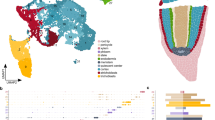Summary
The first of two major steps in the infection process in roots ofParasponia rigida (Ulmaceae) following inoculation byRhizobium strain RP501 involves the invasion ofRhizobium into the intercellular space system of the root cortex. The earliest sign of root nodule initiation is the presence of clumps of multicellular root hairs (MCRH), a response apparently unique amongRhizobium-root associations. At the same time or shortly after MCRH are first visible, cell divisions are initiated in the outer root cortex of the host plant, always subjacent to the MCRH. No infection threads were observed in root hairs or cortical cells in early stages. Rhizobial entry through the epidermis and into the root cortex was shown to occur via intercellular invasion at the bases of MCRH. The second major step in the infection process is the actual infectionper se of host cells by the rhizobia and formation of typical intracellular infection threads with host cell accommodation. This infection step is probably the beginning of the truly symbiotic relationship in these nodules. Rhizobial invasion and infection are accompanied by host cortical cell divisions which result in a callus-like mass of cortical cells. In addition to infection thread formation in some of these host cortical cells, another type of rhizobial proliferation was observed in which large accumulations of rhizobia in intercellular spaces are associated with host cell wall distortion, deposition of electron-dense material in the walls, and occasional deleterious effects on host cell cytoplasm.
Similar content being viewed by others
References
Akkermans, A. D. L., Dijk, C., van, 1981: Nonleguminous root-nodule symbioses with actinomycetes andRhizobium. In: Nitrogen Fixation, Vol. I: Ecology (Broughten, W. J., ed.), pp. 57–103. Oxford: Clarendon Press.
Badenoch-Jones, J., Summons, R. E., Djordjevic, M. A., Shine, J., Letham, D. S., Rolfe, B. G., 1982: Mass spectrometric quantification of indole-3-acetic acid inRhizobium culture supernatants: relation to root hair curling and nodule initiation. Appl. Env. Micro.44, 275–280.
Becking, J. H., 1977: Dinitrogen-fixing associations in higher plants other than legumes. In: A Treatise on Dinitrogen Fixation, Sec. III: Biology (Hardy, R. W. F., Silver, W. S., eds.), pp. 185–275. New York-London-Sydney-Toronto: John Wiley and Sons.
—, 1979: Root-nodule symbiosis betweenRhizobium andParasponia (Ulmaceae). Pl. Soil51, 289–296.
Bhaduri, S. N., 1951: Influence of the numbers ofRhizobium supplied on the subsequent nodulation of the legume host plant. Ann. Bot.15, 209–217.
Callaham, D. A., Torrey, J. G., 1981: The structural basis for infection of root hairs ofTrifolium repens byRhizobium. Can. J. Bot.59, 1647–1664.
Chandler, M. R., 1978: Some observations on infection ofArachis hypogaea L. byRhizobium. J. exp. Bot.29, 749–755.
—,Date, R. A., Roughley, R. J., 1982: Infection and root-nodule development inStylosanthes species byRhizobium. J. exp. Bot.33, 47–57.
Dart, P. J., 1977: Infection and development of leguminous root nodules. In: A Treatise on Dinitrogen Fixation, Sec. III: Biology (Hardy, R. W. F., Silver, W. S., eds.), pp. 367–472. New York-London-Sydney-Toronto: John Wiley and Sons.
Hoagland, D. R.,Arnon, D. I., 1950: The water-culture method for growing plants without soil. Calif. Agric. Exp. Stn., Cir. 347 (rev. ed.).
Hubbell, D. H., Morales, V. M., Umali-Garcia, M., 1978: Pectolytic enzymes inRhizobium. Appl. Env. Micro.35, 210–213.
Martinez-Molina, E., Morales, V. M., Hubbell, D. H., 1979: Hydrolytic enzyme production ofRhizobium. Appl. Env. Micro.38, 1186–1188.
Newcomb, W., McIntyre, L., 1981: Development of root nodules of mung bean (Vigna radiata): a reinvestigation of endocytosis. Can. J. Bot.59, 2478–2499.
Nutman, P. S., 1970: The modified Fahraeus slide technique. In: A Manual for the Practical Study of Root-Nodule Bacteria (Vincent, J. M.), IBP Handbook, No. 15, Appendix III, pp. 144–145. Oxford-Edinburgh: Blackwell Scientific.
Popham, R. A., Henry, R. D., 1955: Multicellular root hairs on adventitious roots ofKalanchoe fedtschenkoi. Ohio J. Sci.55, 301–307.
Pueppke, S. G., 1983:Rhizobium infection threads in root hairs ofGlycine max (L.) Merr.,Glycine soya Sieb. and Zucc., andVigna unguiculata (L.) Walp. Can. J. Micro.29, 69–76.
Puppo, A., Rigaud, J., 1978: Cytokinins and morphological aspects of French bean roots in the presence ofRhizobium. Physiol. Plant.42, 202–206.
Reynolds, E. S., 1963: The use of lead citrate at high pH as an electron-opaque stain in electron microscopy. J. Cell Biol.17, 208–213.
Spurr, A. R., 1969: A low-viscosity epoxy resin embedding medium for electron microscopy. J. Ultrastruct. Res.26, 31–43.
Tjepkema, J. D., Cartica, R. J., 1982: Diffusion limitation of oxygen uptake and nitrogenase activity in the root nodules ofParasponia rigida Merr. and Perry. Plant Physiol.69, 728–733.
Trinick, M. J., 1973: Symbiosis betweenRhizobium and the nonlegume,Trema aspera. Nature244, 459–460.
—, 1979: Structure of nitrogen-fixing nodules formed byRhizobium on roots ofParasponia andersonii Planch. Can. J. Micro.25, 565–578.
—, 1981: The non-legame-Rhizobium association. In: Current Perspectives in Nitrogen Fixation (Gibson, A., Newton, W., eds.), p. 255. Canberra: Aust. Acad. Sci.
—,Galbraith, J., 1976: Structure of root nodules formed byRhizobium on the non-legumeTrema cannabina var.scabra. Arch. Micro.108, 159–166.
— —, 1980: TheRhizobium requirements of the non-legumeParasponia in relation to the cross-inoculation group concept of legumes. New Phytol.86, 17–26.
Wang, T. L., Wood, E. A., Brewin, N. J., 1982: Growth regulators,Rhizobium, and nodulation in peas. Planta155, 345–349.
Author information
Authors and Affiliations
Rights and permissions
About this article
Cite this article
Lancelle, S.A., Torrey, J.G. Early development ofRhizobium-induced root nodules ofParasponia rigida. I. Infection and early nodule initiation. Protoplasma 123, 26–37 (1984). https://doi.org/10.1007/BF01283179
Received:
Accepted:
Issue Date:
DOI: https://doi.org/10.1007/BF01283179




